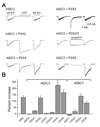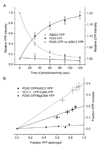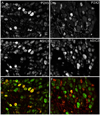Sensing muscle ischemia: coincident detection of acid and ATP via interplay of two ion channels
- PMID: 21092862
- PMCID: PMC3000793
- DOI: 10.1016/j.neuron.2010.09.029
Sensing muscle ischemia: coincident detection of acid and ATP via interplay of two ion channels
Abstract
Ischemic pain--examples include the chest pain of a heart attack and the leg pain of a 30 s sprint--occurs when muscle gets too little oxygen for its metabolic need. Lactic acid cannot act alone to trigger ischemic pain because the pH change is so small. Here, we show that another compound released from ischemic muscle, adenosine tri-phosphate (ATP), works together with acid by increasing the pH sensitivity of acid-sensing ion channel number 3 (ASIC3), the molecule used by sensory neurons to detect lactic acidosis. Our data argue that ATP acts by binding to P2X receptors that form a molecular complex with ASICs; the receptor on sensory neurons appears to be P2X5, an electrically quiet ion channel. Coincident detection of acid and ATP should confer sensory selectivity for ischemia over other conditions of acidosis.
Copyright © 2010 Elsevier Inc. All rights reserved.
Figures







References
-
- Babini E, Paukert M, Geisler HS, Grunder S. Alternative splicing and interaction with di- and polyvalent cations control the dynamic range of acid-sensing ion channel 1 (ASIC1) J Biol Chem. 2002;277:41597–41603. - PubMed
-
- Bautista DM, Jordt SE, Nikai T, Tsuruda PR, Read AJ, Poblete J, Yamoah EN, Basbaum AI, Julius D. TRPA1 mediates the inflammatory actions of environmental irritants and proalgesic agents. Cell. 2006;124:1269–1282. - PubMed
-
- Benson CJ, Eckert SP, McCleskey EW. Acid-Evoked Currents in Cardiac Sensory Neurons: A Possible Mediator of Myocardial Ischemic Sensation. Circ Res. 1999;84:921–928. - PubMed
-
- Benson CJ, McCleskey EW. In: ASICs function as lactic acid sensors during cardiac ischemia. In Molecular Sensors for Cardiovascular Homeostasis. Wang DH, editor. Springer; 2007.
Publication types
MeSH terms
Substances
Grants and funding
LinkOut - more resources
Full Text Sources
Other Literature Sources

